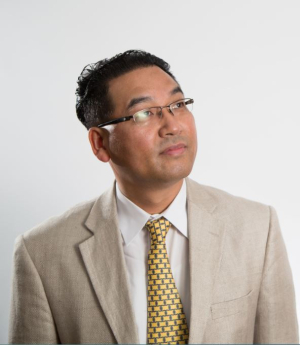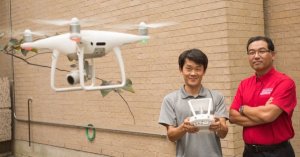In Gino Lim’s estimation, drones will soon take over the sky, delivering medical kits and medicines to rural patients, relaying sensitive military information to troops and, yes, one day picking him up at his Pearland home and delivering him to his office at UH. In fact, the future as he sees it, is something he could drone on about for hours.
“We’re just at the infant stage with drones right now,” said Professor Lim, chair of the Cullen College’s department of industrial engineering and Hari and Anjali Agrawal Faculty Fellow. “Imagine 15 years ago where iPhones were and now everyone uses them. I’ll tell you right now, drones will be like that in no more than 15 years from today.”
He touched on the relevance of drones in medicine with his Ph.D. student Seon Jin Kim in their article called “Drone-aided healthcare services for patients with chronic diseases in rural areas.”
Houston work will impact S. Korean military
Kim’s official title is Major Kim, engineer in the South Korean army. He’s on a four-year leave of absence to work under Lim’s tutelage.
“Here at UH, Dr. Lim is my commander,” laughs Kim, and then quickly corrects himself: “No, he’s my general!” Kim expects to take the lessons learned with Lim back to South Korea for practical use in the military. They’ve published another paper called “Drone relay stations for supporting wireless communication in military operations.”
Lim initiated the concept of applying drones to real-world problems.
“We provided a template for drone routes to help healthcare services, especially targeting chronic patients in rural areas,” said Kim. Their template includes the locations and number of healthcare centers in specific areas and determines the optimal number of drones needed in each center.
Because chronic patients need recurring treatment and rural patients live far from treatment centers, they propose that drones will close the healthcare disparity among those groups.
Lim says that older patients who live far from doctors or hospitals can actually put more lives at risk.
“They need medical attention and if they are forced to drive, they and others could be in jeopardy,” said Lim. “When drones can deliver the necessary medicine or testing kits and be sent back, unnecessary traffic will be reduced.”
If it sounds like a brave new world, that’s because it is. And Lim is helping usher it in, setting up the mathematical models to better utilize drones for everything we do.
It’s the future
Lim’s drone work spans the highly imaginative to the minutely specific. “The mathematical models we are setting up will allow us to better utilize the drones and map drone routes across all applications. In Houston, for example, we could utilize drones to find out where flooding is happening in real time or where power needs to be restored,” he said.
Lim says in military operations drones are better communication systems than satellites.
“Satellites are wonderful things, but there are delays,” said Lim. “With drones, you get real time information because they are so close to the ground and you control them 100 percent.” Lim posits that drones, because they fly so low, can see real enemies or equipment on the ground communicating those finds in real time, like a live television signal. Ultimately, Lim says, if the drone gets shot down, it’s just the cost of doing military business. And that cost is greatly reduced.
“Imagine satellites and their cost – millions of dollars,” said Lim. “A drone might be $500.”
Science ascending
In Dubai they’re testing drones you can ride on. Lim would love to take that ride, if even as a carpool to work. But mainly he wants to continue on the frontier of drone advancement.
“I know that drones are our future, there’s no doubt about it,” he repeats emphatically. “I want to stay in the mainstream in improving the efficiency of drones, including extending battery life and improving their reliability.”
Lim begins just about every other sentence with the word “imagine:”
“Imagine 15 years from now…”
“Imagine driverless cars as a concept years ago…”
Lim’s vivid imagination combined with engineering prowess will create the kind of drone efficiencies that will aviate and soar for decades to come.

